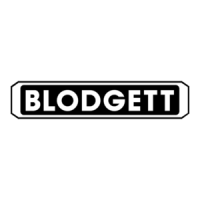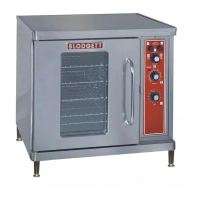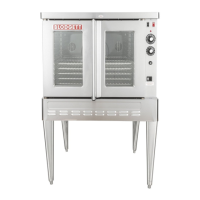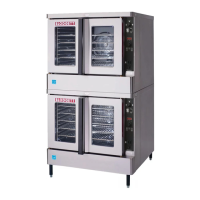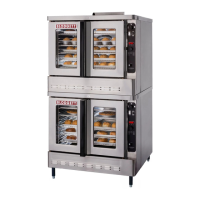MARK V
2-17
INTELLIHOLD AND INTELLIPLUS - 22027 REV A
Component Reference
NOTE: Refer to FIGURE 8 page 2-18 for compoĆ
nent locations.
1. MODE SELECTOR SWITCH
2. DOOR SWITCH
3. AXIAL FAN
4. TEMPERATURE CONTROL BOARD
5. CONVECTION FAN
6. OVEN READY LIGHT
7. HEATING ELEMENT CONTACTOR
8. HEATING ELEMENTS
9. 50 WATT LAMPS
10. LIGHT SWITCH
11. PROBE
Operation
1. Turn the mode selector switch (1) to the cook
position. Power goes to one side of the door
switch (2), the axial fan (3) and to either E1 or
E2 of the temperature control board (4).
NOTE: This control is multiĆvoltage. It may be
used on 240, 208 and 120. FIGURE 8
shows connections to E1 and E2 indiĆ
cating a 240 or 208 volt application.
2. If the doors are closed the door switch (2)
should also be closed sending power to termiĆ
nal E10 of K2, E8 of K3 and E6 of K1. If a time
and temperature is programmed into the conĆ
troller either K2 or K3 close sending power to
the convection fan (5).
NOTE: K2 is for high fan, K3 is for low fan.
3. On a call for heat the contacts in K1 close,
sending power to the oven ready light (6) and
one side of the heating element contactor (7).
When the contactor closes the heating eleĆ
ments (8) power up.
4. The 50 watt lamps (9) only receive power when
the light switch (10) is activated. These lamps
are 115 volt and are wired in series parallel.
NOTE: Turn the mode selector switch to cool
down to bypass the door microswitch. This
allows the convection fan motor to operate
even when the doors are open.
NOTE: This oven may be converted from single to
three phase, however, contactors must be
changed due to the difference in amp
draw. Reference detail inset in FIGURE 8.
NOTE: The resistive values for the probe (11) used
in this oven have ascending temperature
coefficients. As the temperature increases
the resistive values also increase.
NOTE: Reference page 4-2 of the TroubleshootĆ
ing section for the reistive values of the
heating elements. The reading should be
taken in a cold state.
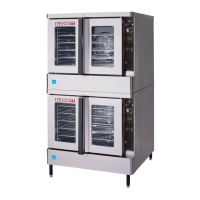
